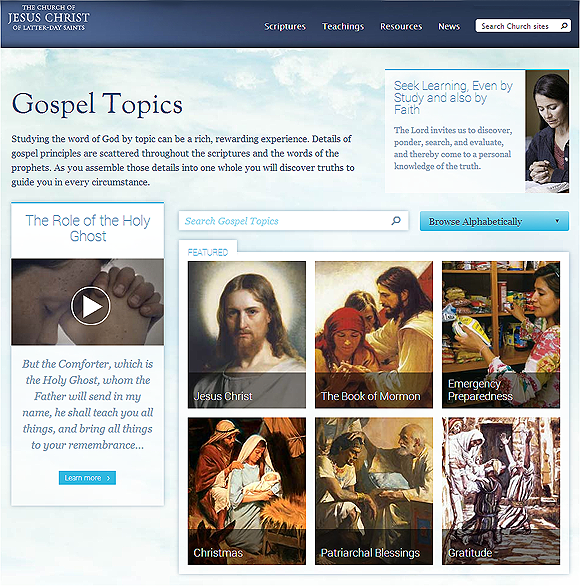Whenever the FLDS, led by Warren Jeffs, appears in the news, people become confused. They mistakenly believe the reports refer to The Church of Jesus Christ of Latter-day Saints, whose members are nicknamed Mormons. Although both use the Book of Mormon in addition to the Bible, they aren’t connected in any way. The mainstream LDS (Mormon) faith has no control over the actions of the FLDS, any more than the Catholics can control the Protestants. FLDS stands for Fundamentalist Latter Day Saints. The Mormons usually abbreviate their own church name to LDS, meaning Latter-day Saints.
The FLDS broke away from the LDS religion . The Mormons had ended the practice of polygamy, and those who eventually became the FLDS were upset over the decision. They rejected the Mormon prophet of the time, Wilford Woodruff, and formed their own religion, initially using the name The Work or The Priesthood Work. In 1942, they became the United Effort Plan. In 1991, they selected the name they currently use. Their group has divided many times over the years, and today few who belong to the FLDS ever belonged to The Church of Jesus Christ of Latter-day Saints. There are many splinter groups that have formed from those leaving the FLDS, and these are also not part of the LDS religion.
The FLDS lists the first three Mormon prophets as their own prophets as well: Joseph Smith, Brigham Young, and John Taylor. Since they rejected the fourth prophet, Wilford Woodruff, their list then continues on with completely different leaders from the Mormon list of prophets. All doctrines introduced since that time by the Mormons were rejected by the FLDS, and they created their own canon of doctrines. Their teachings today are very different from most teachings taught by the Mormons.
Their membership is very small, numbering just 11,000 at the time of the recent raid on their compound in Texas. The Church of Jesus Christ of Latter-day Saints currently has 15 million members. The current leader of the FLDS is Warren Jeffs, who is in prison. The current leader of the LDS people is Thomas S. Monson, who is not and never was a polygamist.
Today’s Mormonism does not allow polygamy. On LDS.org, the official website for Mormons, this statement appears on the Gospel Topics page for polygamy:
The family is ordained of God. Marriage between man and woman is essential to His eternal plan. At certain times and for His specific purposes, God, through His prophets, has directed the practice of plural marriage (sometimes called polygamy), which means one man having more than one living wife at the same time. In obedience to direction from God, Latter-day Saints followed this practice for about 50 years during the 1800s but officially ceased the practice of such marriages after the Manifesto was issued by President Woodruff in 1890. Since that time, plural marriage has not been approved by The Church of Jesus Christ of Latter-day Saints and any member adopting this practice is subject to losing his or her membership in the Church.
This video show Gordon B. Hinckley, a past Mormon prophet, speaking on the differences between Mormons and the FLDS.
Polygamy, as it was practiced by the Mormons in the 1800s, was very different from the practices of the FLDS today. It was never mandatory, nor was it considered necessary in order to be exalted, as it is in the FLDS organization. The FLDS has practiced the law of “placing,” which the Mormons never used. In this practice, wives are assigned to men and may be reassigned to new husbands, along with his children, if a man is determined to need punishment or for any other reason. FLDS marriages are assigned, and it is considered essential to practice polygamy in order to achieve exaltation.
When the Mormons practiced polygamy more than a century ago, it was never required and was, in fact, a minority practice, involving only five to thirty percent of families. While it appears that FLDS men have been required to have at least three wives, LDS polygamists usually had no more than two, but no particular number was specified. Many outsiders were shocked that Mormon women fought to preserve polygamy, not understanding that it was voluntary and that for some, it provided freedom and benefits other women did not have.
Placing was not practiced by the LDS polygamists. Men selected their own wives, unless the Church was specifically asked for assistance, and they had to seek the approval of the women they wished to marry. Women were free to reject all marriage offers, as were men. The first wife had to give approval, as well. They then sought permission from the Church, in order to demonstrate they could properly care for the additional family and had permission from the women involved. The majority of LDS women who entered into plural marriages (the term Mormons used for polygamy) were divorced or widowed. Although teenagers did sometimes enter into marriages, this was a common practice in that era, when twelve was often the legal age for marriage, and women ages fourteen and older were considered old enough to marry. It is essential that we not evaluate past behavior by today’s standards. “Teenager” is a very recent category for young people. Throughout most of history, teenagers were considered adults and many were employed full-time to help support their families or were living independently.
Although divorce was discouraged in ordinary situations, a woman who entered into polygamy and then realized she couldn’t adjust was granted a divorce. Men who came to that same conclusion were sent back to work harder on their marriages, although divorce was possible. It was a system that gave women a great deal of power. In fact, many of the women felt they had more freedom than did women in non-polygamous marriages. Many of them had careers or went back to school for advanced education. Some went east to work in the suffrage movement, doing so with the support of their spouses. One even ran for office against her own husband and won. Brigham Young encouraged women to take on non-traditional careers, and many were encouraged to become doctors or bookkeepers long before that became acceptable in the rest of the country.
Emmaline Wells was one woman who often said she had more freedom than women whose husbands were entirely focused on them. Without the full-time responsibility for a husband, she was free to be the editor of a magazine that advocated for women to become involved in politics. She developed a friendship with Susan B. Anthony during her many trips east and served as the vice-president of the Women’s Suffrage Association, successfully helping Utah women regain the vote the federal government had taken from them.
Eliza R. Snow, who was wife to Joseph Smith and, after she was widowed, to Brigham Young, also felt that polygamy, done correctly, was not harmful to women:
I will now ask of this assemblage of intelligent ladies, Do you know of any place on the face of the earth, where woman has more liberty and where she enjoys such high and glorious privileges as she does here as a Latter-day Saint? No! the very idea of a woman here in a state of slavery is a burlesque on good common sense … as women of God, filling high and responsible positions, performing sacred duties—women who stand not as dictators, but as counselors to their husbands, and who, in the purest, noblest sense of refined womanhood, are truly their helpmates—we not only speak because we have the right, but justice and humanity demands we should! (quoted in Jaynann Morgan Payne, “Eliza R. Snow: First Lady of the Pioneers,” Ensign, Sep 1973, 62).
Mormon women held a convention in January of 1870 to demonstrate their support of Mormon womanhood. This meeting was attended by reporters who were baffled to find that Mormon women were not what they expected. These women spoke intelligently about polygamy and their roles as women in the world. They demonstrated the commitment to education Mormons had for all its members, including its women. A reporter wrote, “In logic and in rhetoric the so-called degraded ladies of Mormondom are quite equal to the … women of the East.”
Today’s Mormons live very differently from those living in the Texas compound operated by the FLDS. Mormons do not live in isolated communities, but are found all over the world in ordinary neighborhoods, in community places of employment, and in public schools. They dress in modern clothing—modest, but fashionable. Mormon women are not required to wear dresses that go to the ground or to select only certain colors of clothing. They wear stylish hairstyles and may have their hair short or long, as they choose. Marriages are never arranged and the husband and wife are considered equal partners in the home.
Mormons consider marriages consisting of one man and one women to be God’s standard for marriage. Polygamy is practiced only when commanded by God for His purposes. The need for polygamy ended more than one hundred years ago and is not permitted by Mormons even in countries where it is legal. People who practice polygamy may not join the Church unless they end their additional marriages and agree to meet the needs of the children from those families.
While the names may be similar, the religions are far from each other in practice and doctrine.
Sources:
Polygamy Then and Now, LDS Newsroom, 5 May 2008
Differences from Polygamous Groups, LDS Newsroom, June 2008
Daughters in My Kingdom, chapter 4
About Terrie Lynn Bittner
The late Terrie Lynn Bittner—beloved wife, mother, grandmother, and friend—was the author of two homeschooling books and numerous articles, including several that appeared in Latter-day Saint magazines. She became a member of the Church at the age of 17 and began sharing her faith online in 1992.






I want to thank you for this article. I am a member of the LDS church and was curious more than anything in regards to our differences. This was well written and made a complicated and even a sensitive subject easier to understand. Thanks again.
WHO IS THE LEADER OF THE RLDS NOW?
A few years ago the RLDS church became the Community of Christ Church. Their current leader since March 2005 is Stephen M. Veazey according to Wikipedia.